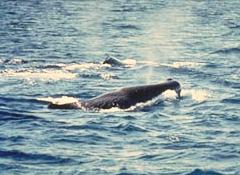Sperm whale family
|
|
| Sperm whale family | ||||||||||||
|---|---|---|---|---|---|---|---|---|---|---|---|---|
 Two Sperm Whales | ||||||||||||
| Scientific classification | ||||||||||||
| ||||||||||||
| Genera | ||||||||||||
The sperm whale family or simply the sperm whales is the collective name given to three species of whale, the Sperm Whale, the Pygmy Sperm Whale and the Dwarf Sperm Whale. There are three different taxonomic interpretations of this 'family'. The last of these listed here is the one that has generally been used since 1998.
- (see [1]) All three species are members of the Kogiidae family.
- (see [2]) Physeteridae recognised as the single family with Kogiinae as a subfamily. Alternatively Physeteroidea is called a superfamily and contains Kogiidae as a family.
- (see [3]) Two distinct families - Physeteridae and Kogiidae.
In any case there is complete agreement that there are two genera - Physeter containing one species - the Sperm Whale - and Kogia containing the Dwarf Sperm Whale and Pygmy Sperm Whale.
The common characteristic of each species is the spermaceti, a semi-liquid waxy white liquid filling the case or spermaceti organ in the whale's head. See the individual species articles for further details.
Sperm whales are known to dive incredible depths the find food. Sperm whales eat squid fish and even sharks. They belong to the group of toothed whales which have teeth instead of baleen. The sperm whale has the largest brain of any animal on earth though this does not imply they are particularly intelligent.
References
- Order Cetacea by Mead and Brownell in Mammal Species of the World, Wilson and Reeder (eds), Smithsonian Institute Press.
- Cetacean Societies Field Studies of Dolphins and Whales, Mann, Connor, Tyack and Whitehead (eds), ISBN 0226503410
- Rice, Dale W. (1998). Marine mammals of the world: systematics and distribution. Society of Marine Mammalogy Special Publication Number 4. 231 pp.de:Pottwale
